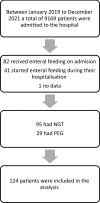Characteristics of older adults receiving enteral feeding at a geriatric medical center
- PMID: 39044128
- PMCID: PMC11265322
- DOI: 10.1186/s12877-024-05202-y
Characteristics of older adults receiving enteral feeding at a geriatric medical center
Abstract
Background: Malnutrition is a prevalent and hard-to-treat condition in older adults. enteral feeding is common in acute and long-term care. Data regarding the prognosis of patients receiving enteral feeding in geriatric medical settings is lacking. Such data is important for decision-making and preliminary instructions for patients, caregivers, and physicians. This study aimed to evaluate the prognosis and risk factors for mortality among older adults admitted to a geriatric medical center receiving or starting enteral nutrition (EN).
Methods: A cohort retrospective study, conducted from 2019 to 2021. Patients admitted to our geriatric medical center who received EN were included. Data was collected from electronic medical records including demographic, clinical, and blood tests, duration of enteral feeding, Norton scale, and Short Nutritional Assessment Questionnaire score. Mortality was assessed during and after hospitalization. Data were compared between survivors and non-survivors. Multivariate logistic regressions were performed to identify the variables most significantly associated with in-hospital mortality.
Results: Of 9169 patients admitted, 124 (1.35%) received enteral feeding tubes. More than half of the patients (50.8%) had polypharmacy (over 8 medications), 62% suffered from more than 10 chronic illnesses and the majority of patients (122/124) had a Norton scale under 14. Most of the patients had a nasogastric tube (NGT) (95/124) and 29 had percutaneous endoscopic gastrostomies (PEGs). Ninety patients (72%) died during the trial period with a median follow-up of 12.7 months (0.1-62.9 months) and one-year mortality was 16% (20/124). Associations to mortality were found for marital status, oxygen use, and Red Cell Distribution Width (RDW). Age and poly-morbidity were not associated with mortality.
Conclusion: In patients receiving EN at a geriatric medical center mortality was lower than in a general hospital. The prognosis remained grim with high mortality rates and low quality of life. This data should aid decision-making and promote preliminary instructions.
Keywords: Enteral feeding; Enteral nutrition (EN); Geriatric; Long- term; Mortality; Nasogastric tube feeding; Older adults.
© 2024. The Author(s).
Conflict of interest statement
The authors declare no competing interests.
Figures



References
-
- World Health Organization. World Report on Aging and Health. http://www.who.int/publications/i/item/9789241565042.2015.
MeSH terms
LinkOut - more resources
Full Text Sources
Research Materials

